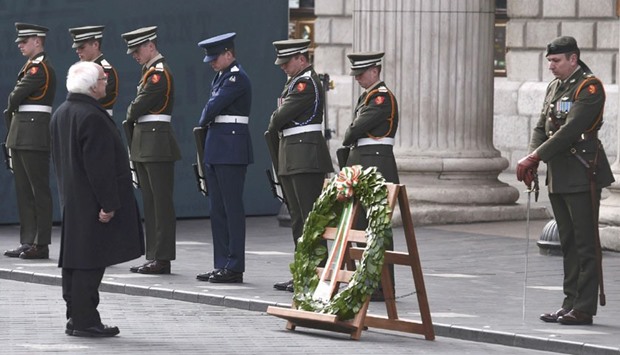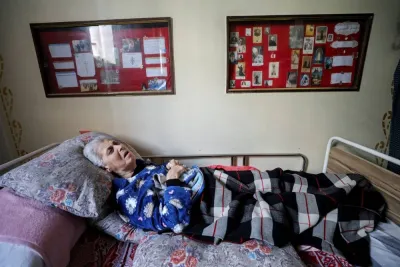
Irish President Michael D Higgins lays a wreath in front of the GPO during the commemoration of the 100 year anniversary of the Irish Easter Rising in Dublin, Ireland, yesterday.
Thousands of members of Ireland’s armed forces marched through Dublin yesterday to mark 100 years since the Easter 1916 uprising, the defining moment of an independence struggle that ended centuries of British rule five years later.
The rebellion has been described as a “triumph of failure” because, while the rebels surrendered and were executed after five days, their uprising galvanised the independence movement.
Prime Minister Enda Kenny oversaw the commemorations in an acting capacity after his coalition government failed to secure re-election on February 26, creating a political stalemate that has shown little sign of resolution.
Kenny, along with Ireland’s president and members of the cabinet, watched silently as the Irish flag was raised in the yard of Kilmainham Gaol where leaders of the uprising were executed, inflaming public opinion against the British government.
“From the ashes of the Rising, the subsequent War of Independence and Civil War arose a free and democratic Irish state,” Kenny said in a speech yesterday.
The rising remains controversial for some who say the commemorations celebrate militant Irish nationalism.
Arlene Foster, First Minister of Northern Ireland, which remains part of the United Kingdom, refused to take part in the commemorations, saying the Rising was used to justify Irish Republican Army violence in the 1970s and 80s.
While the IRA disbanded after a 1998 peace deal, police in Belfast have warned of a “severe” threat to security forces during the commemorations by dissident nationalist militants opposed to continued British rule in Northern Ireland.
Tens of thousands lined streets on a bright Sunday morning in Dublin to watch the parade snake past strategic buildings seized by poorly trained insurgents in their audacious attack on the British administration in the middle of World War I.
The rebels’ Proclamation of Independence was read by a soldier at midday at their headquarters, the General Post Office. The rebels surrendered near the building under heavy British shelling after five days.
Opponents of Kenny’s Fine Gael party criticised what they said was a cautious embrace of the rebels’ legacy after a video to commemorate the Rising featured rugby players and Queen Elizabeth but none of the insurgents.
A banner on a building in the centre of Dublin featuring the face of John Redmond, a bitter opponent of the rising, was defaced in recent days. Redmond has been praised by John Bruton, a former head of Fine Gael, as offering a constitutional alternative to the violence of 1916.
Left-wing parties have also used the commemorations to highlight the failure to implement the egalitarian ideals of the 1916 uprising.
“This state is not the Republic proclaimed in 1916 and current efforts to pretend that it is are an insult to the men who lie here,” said Gerry Adams, leader of the country’s third largest party, Sinn Fein, at a rival commemoration event on Friday at the grave of some of the rebels.


